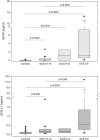Serum Concentrations of Ubiquitin C-Terminal Hydrolase-L1 and Glial Fibrillary Acidic Protein after Pediatric Traumatic Brain Injury
- PMID: 27319802
- PMCID: PMC4913316
- DOI: 10.1038/srep28203
Serum Concentrations of Ubiquitin C-Terminal Hydrolase-L1 and Glial Fibrillary Acidic Protein after Pediatric Traumatic Brain Injury
Abstract
Objective reliable markers to assess traumatic brain injury (TBI) and predict outcome soon after injury are a highly needed tool for optimizing management of pediatric TBI. We assessed serum concentrations of Glial Fibrillary Acidic Protein (GFAP) and Ubiquitin C-Terminal Hydrolase-L1 (UCH-L1) in a cohort of 45 children with clinical diagnosis of TBI (Glasgow Coma Scale [GCS] 3-15) and 40 healthy subjects, evaluated their associations with clinical characteristics and outcomes, and compared their performance to previously published data on two well-studied blood biomarkers, S100B and MBP. We observed higher serum levels of GFAP and UCH-L1 in brain-injured children compared with controls and also demonstrated a step-wise increase of biomarker concentrations over the continuum of severity from mild to severe TBI. Furthermore, while we found that only the neuronal biomarker UCH-L1 holds potential to detect acute intracranial lesions as assessed by computed tomography (CT), both markers were substantially increased in TBI patients even with a normal CT suggesting the presence of undetected microstructural injuries. Serum UCH-L1 and GFAP concentrations also strongly predicted poor outcome and performed better than S100B and MBP. Our results point to a role of GFAP and UCH-L1 as candidate biomarkers for pediatric TBI. Further studies are warranted.
Figures


References
-
- Geneva, World Health Organization. World report on child injury prevention. http://whqlibdoc.who.int/publications/2008/9789241563574_eng.pdf, (2008) (Date of access: 21/01/2015). - PubMed
-
- Field M., Collins M. W., Lovell M. R. & Maroon J. Does age play a role in recovery from sports-related concussion? A comparison of high school and collegiate athletes. J Pediatr 142, 546–553 (2003). - PubMed
-
- Giza C. C., Griesbach G. S. & Hovda D. A. Experience-dependent behavioral plasticity is disturbed following traumatic injury to the immature brain. Behav Brain Res 157, 11–22 (2005). - PubMed
-
- Anderson V., Catroppa C., Morse S., Haritou F. & Rosenfeld J. Recovery of intellectual ability following traumatic brain injury in childhood: impact of injury severity and age at injury. Pediatr Neurosurg 32, 282–290 (2000). - PubMed
-
- Laribi S. et al.. S100B blood level measurement to exclude cerebral lesions after minor head injury: the multicenter STIC-S100 French study. Clin Chem Lab Med: CCLM/FESCC 52, 527–536 (2014). - PubMed
Publication types
MeSH terms
Substances
Grants and funding
LinkOut - more resources
Full Text Sources
Other Literature Sources
Medical
Miscellaneous

